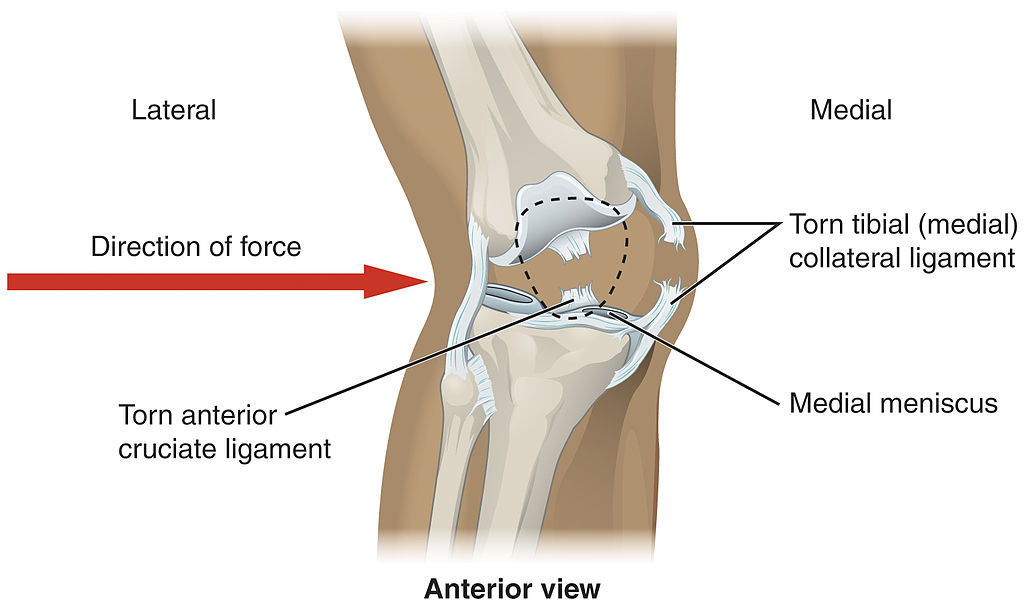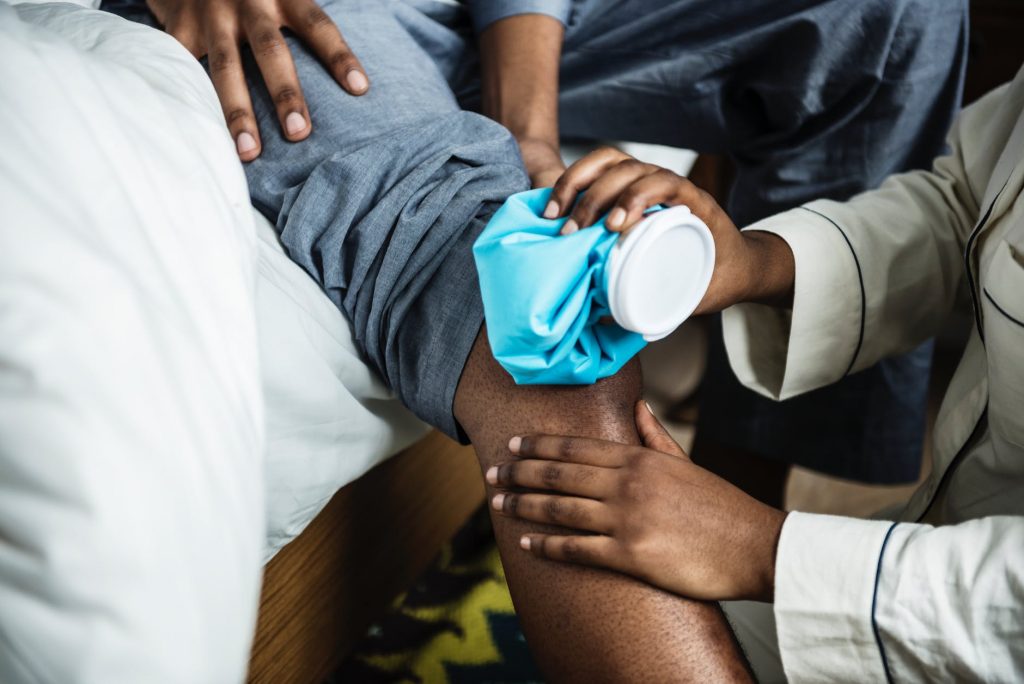The meniscus is cartilage that cushions the area between the femur (the thigh bone) and the tibia (the shin bone). In each knee joint, there are two menisci. They can be torn or damaged during activities that require rotation or place pressure on the knee joint. On average – approximately 500,000 meniscus tears occur within the US annually.

Treatment for such tears depends heavily on the severity of the issue. In many instances, home remedies, physical therapy, and exercises may successfully treat meniscus tears. In other cases, surgery may be required. In all cases, performing certain exercises have proven effective for preventing a torn meniscus.
Torn Meniscus
The two menisci in each of the knees is a piece of cartilage that is C-shaped. It provides a cushion between the thigh and the shin of the leg. The tearing of this cartilage is considered to be one of the most common of all knee injuries experienced. A torn meniscus occurs when there is a forceful twist or quick, hard rotation on the knee. This is especially true if the full weight of the body is involved.
If the menisci develop into a shape that reflects a block or a type of disk, a condition develops which is referred to as “discoid meniscus”. If an individual has this type of meniscus, they are more likely to suffer from a torn meniscus at some point in their life.

Torn Meniscus Symptoms
The symptoms experienced by an individual that suffers from a torn meniscus will vary according to what activity caused the issue, the severity of the issue, and the sufferer’s general health. However, the following outlines the most common of the torn meniscus symptoms:
- When the injury occurs, it is common for the sufferer to hear a sound that resembles that of a pop in or around the knee joint.
- Pain is considered to be the most commonly experienced symptom. This may occur on the inside of the knee, the outside of the knee, or in the back area of the knee. In some instances, the pain only occurs when the area is touched. In others, it presents as constant pain.
- When a meniscal injury occurs, it is common for the knee and the surrounding area to become inflamed and swell up.
- The knee joint may become stiff. As a result, it may be extremely difficult to move the knee and experience a full range of motion.
- Many sufferers will complain of the feeling that the knee is “catching” or it is “locking up” when the meniscal becomes torn.
- It may feel as if the knee is unable to support the weight of the body or that it is giving way.
- It is often challenging to straighten the knee up completely when a meniscal tear occurs.
- When a meniscal tear happens, it is often very difficult to bend the knee joint completely.
- It may be extremely difficult to walk when the meniscal is torn. As a result, limping may occur.

Treatment for Meniscal Injury
In most instances, the treatment for meniscal injury starts off in a conservative manner. Of course, this all depends on the location, the size of the tear, and the overall severity of the injury. The following represents the most common initial treatments:
- Rest – When advised to rest, patients are informed to avoid any activities that may result in knee pain. It is specifically advised to avoid those activities that require the knees to twist, to rotate, or to pivot in any manner. This course of treatment may also result in the patient being prescribed crutches so that pressure and weight is kept off of the knee and the process of healing may occur.
- Ice Application – Due to the pain and swelling that commonly occurs with a meniscal injury, the medical specialist will often recommend the application of ice or another frozen product for approximately 10 to 15 minutes at a time while the knee is elevated. Ice application may be used once every 4 hours until higher levels of comfort are accomplished.
- Over-the-Counter Pain Relievers – Due to the immense swelling and discomfort that may accompany a meniscal tear, the use of over-the-counter pain relievers may be advised. NSAIDs – such as ibuprofen – can aid in the reduction of swelling and acetaminophen – such as Tylenol – can help with general pain and discomfort.
- Physical Therapy – In order to stabilize and support the knee, promote the healing process, and accumulate strength in the muscles that surround the knee, physical therapy may be prescribed as an initial treatment. Out of all of the initial treatments for meniscal tears, physical therapy is considered to be the most productive.
- Exercise Therapy – Many medical professionals will treat this type of knee injury using exercise therapy. The exercises may be performed both in a facility with trained physical therapists and at home. In most cases, exercise therapy goes hand-in-hand with physical therapy in an effort to re-strengthen the knee and support the healing process.
The last resort treatment for a torn meniscal is surgery. This is often advised when the knee is extremely painful for a long time after the tear, initial treatments were ineffective, and/or there is a need to repair the meniscus due to limited range of motion and deformities that result in knee locks and mobility problems. Continue reading to learn more about surgery.
Torn Meniscus Surgery
If treatments for a meniscus tear fail to work or if the tear is considered to be “severe”, a doctor will likely recommend surgery. Prior to this recommendation, two actions will likely be performed to ensure that surgery is the best option.
The first is an MRI.
The second is the exploration of the tear through an arthroscope. Basically, this is the insertion of a very thin instrument that has a light and a camera so that the joints of the knee may be observed. If it is determined that the tear is mild, surgery will not be recommended; however, if it is severe, the following may be recommended:
- Repair by Arthroscope – If the doctor explores the joint and determines it is on the severe side, he may choose to repair it while inside of the joint. Basically, he will do a basic stitch. The stitches used will dissolve naturally in the body so that the small incision will not have to be reopened at a later date.
- Arthroscopic Partial Meniscectomy – This procedure involves removing a section of the tear so that it does not further inhibit the overall functionality of the knee.
- Arthroscopic Total Meniscectomy – If the tear is very severe, the doctor performing the operation will remove the entire meniscus.
Overall, surgical proceedings related to meniscus repair have a low risk of complications. However, there are many situations that may develop.
These include injury to the nerves in the surrounding area, the development of infections in the region, as well as the onset of stiffness within the knee.
In nearly all cases, antibiotics will be prescribed after surgery to prevent and/or treat infections. Furthermore, additional steps may be taken to ensure comfort and prevent blood clots – such as wearing compression stockings, a cast, or a brace.
ost people require crutches for about a month as to avoid placing pressure/weight on the knee.
Afterward, physical therapy and exercise therapy will be prescribed to promote healing.
Torn Meniscus Exercises
In order to heal a torn meniscus, there are several different exercises that may be performed. These are designed to aid in maintaining the overall strength of the muscles located in the front of the thigh, the back of the thigh, the hip, and the calf.
It is advised that these exercises only be performed if there is only a small amount of pain. The following outlines the most productive exercises for a torn meniscus, with a brief description of each:
- Quad Sets – This exercise helps to build strength in the muscle group located at the top of the thigh. Simply sit on the floor with the affected leg straight out. Press the knee to the floor in order to tighten up the muscles. Hold for about 5 seconds, rest for double that time, and repeat.
- Hamstring Curls – These exercises will help strengthen up the muscles located in the back of the thigh. Lie on your stomach with the knees straight out. Lift the foot of the affected leg towards the back. You may add an ankle weight to enhance the effects.
- Standing Knee Bends – This will help strengthen the upper leg muscles. Stand behind a chair and hold the back of it. Bend the knees so that you are going into a squat or sitting position. Lower the body only about 6 inches.
We Can Help Get You Back into Motion
We here at Back to Motion can assist you in getting back into motion! If you have experienced a torn meniscus, contact us today for assistance.
